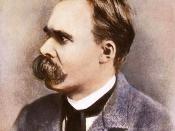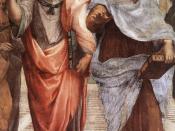Since the beginning of human history, men desired to understand the entities that surround them. People who chose the love of knowledge as a way of life asked questions to reveal the unknown. Mankind called these curious people philosophers. They tried to find and define what being is, what human being is, what goodness and badness are that is to say they wanted to understand the ideas and the entities around them. The concepts of truth and real being were two of the most crucial issues that Plato and Nietzsche, two of these curious philosophers, had tried to explain during their times. Both Plato and Nietzsche used their mental power to interpret perceptions that they acquired from their environment; however they practiced different methods and made different conclusions. Plato and Nietzsche tried to find out the bases that lie under those perceptions, and they went into deeper levels in their questionings.
In his "Allegory of the Cave", Plato developed two realms called the visible realm and the invisible realm to explain what truth is. Plato considered the visible realm to be the realm of appearances which consists of concepts and senses. For Plato, the appearances realm is in a state of a never ending change. Therefore, Plato claimed that because the appearances realm always changes, man can never achieve reaching the certain knowledge of such unstable things in this realm. Plato believed that the ideas are concealed behind these appearances that we ordinarily consider as true and real. Plato asserted that taking our deficient perceptions as ground. Whatever we know, see, hear, touch and believe as the truth is indeed not the exact truth but just beliefs which can be true or false. This assertion leads him to point out the states of knowledge and ignorance of...



Good
Good Job! I really liked this essay, I think it is adequate for College level.
0 out of 0 people found this comment useful.